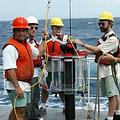 過去氣候研究專家相信,海洋可以吸收足夠的二氧化碳,降低全球暖化的速度,但由國際科學團隊所進行的最新研究發現,海洋對於大氣或氣候變化所能造成的影響相當有限。
過去氣候研究專家相信,海洋可以吸收足夠的二氧化碳,降低全球暖化的速度,但由國際科學團隊所進行的最新研究發現,海洋對於大氣或氣候變化所能造成的影響相當有限。
研究結果指出,二氧化碳不會消失不見,通常是透過動物和細菌消耗掉,並且在「弱光區」再次循環,弱光區是指海面下100至1000公尺處,模糊昏暗的區域。
碳在深海地區可以被加以儲存,避免重新進入大氣中成為溫室氣體,但是因為碳常常無法進入深海領域,因此海洋在溫室氣體的吸收和儲存作用上,並不如科學家預期的重要。
該研究同時也發現,把海水加入鐵,以減緩氣候變化的建議,執行上有其困難。加鐵的目的是要刺激光合作用海洋植物的成長,藉此將更多的二氧化碳從空氣中轉換到深海中。
當大部分的研究都在調查海水表面的同時,少數研究也已開始將目標轉向海水下的碳循環。為了替向來難以探索的弱光區開啟新的窗口,VERTIGO研究團隊檢視各種過程,他們使用大量的新式研究工具,其中一項實驗裝置更讓他們克服了長久以來所面臨的問題,也就是收集掉入弱光區的海雪。
Climate experts have relied on the oceans to absorb enough of the greenhouse gas carbon dioxide to slow global warming, but new research by an international team of scientists shows that the oceans may have little impact on changes in the atmosphere or climate.
The research indicates that instead of sinking, carbon dioxide is often consumed by animals and bacteria and recycled in the "twilight zone," a dimly lit area 100 to 1,000 meters below the surface.
Because the carbon often never reaches the deep ocean, where it can be stored and prevented from re-entering the atmosphere as a green-house gas, the oceans may not be able to perform the crucial role in greenhouse gas absorption and storage that has been assumed.
The study adds a new complication to proposals to mitigate climate change by fertilizing the oceans with iron. The iron was supposed to promote blooms of photosynthetic marine plants and transfer more carbon dioxide from the air to the deep ocean.
While many studies have investigated the surface of the ocean, little research has been conducted on the carbon cycle below. The VERTIGO team examined a variety of processes to open a new window into the difficult-to-explore twilight zone. They successfully used a wide array of new tools, including an experimental device that overcame a longstanding problem of how to collect marine snow falling into the twilight zone.





